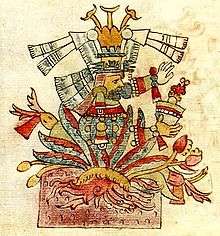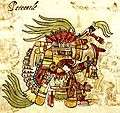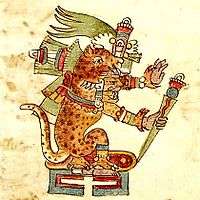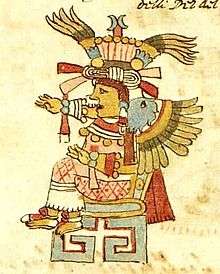Codex Ríos
A painting of Tlaloc, as shown on page 20R of Codex Ríos.
Codex Ríos is an Italian translation and augmentation of a Spanish colonial-era manuscript, Codex Telleriano-Remensis, that is partially attributed to Pedro de los Ríos, a Dominican friar working in Oaxaca and Puebla between 1547 and 1562. The codex itself was likely written and drawn in Italy after 1566.
The manuscript is focused on the Tolteca-Chichimeca culture in the Tehuacan Valley in modern-day Puebla and Oaxaca. It can be divided into seven sections:[1]
- Cosmological and mythological traditions with emphasis on the four epochs.
- An almanac, or tonalamatl, for the 260-day divinatory year common in Mesoamerica.
- Calendar tables for the years 1558 through 1619, without drawings.
- An 18-month festival calendar, with drawings of the gods of each period.
- Ritual customs, with portraits of Indians.
- Pictorial chronicles for the years 1195-1549 beginning with the migration from Chicomoztoc and covering later events in the Valley of Mexico.
- Glyphs for the years 1556 through 1562, without drawings or text.
Codex Ríos consists of 101 pages of European paper, accordion-folded. It is held in the Vatican Library, Rome, and is also variously known as Codex Vatican A, Codex Vaticanus A, and Codex Vaticanus 3738.
References
- ↑ "FAMSI - Akademische Druck - u. Verlagsanstalt - Graz - Codex Vaticanus 3738". Akademische Druck - u. Verlagsanstalt - Graz CODICES. FAMSI. Retrieved 29 July 2014.
Gallery
See also
This article is issued from Wikipedia - version of the 5/1/2016. The text is available under the Creative Commons Attribution/Share Alike but additional terms may apply for the media files.





